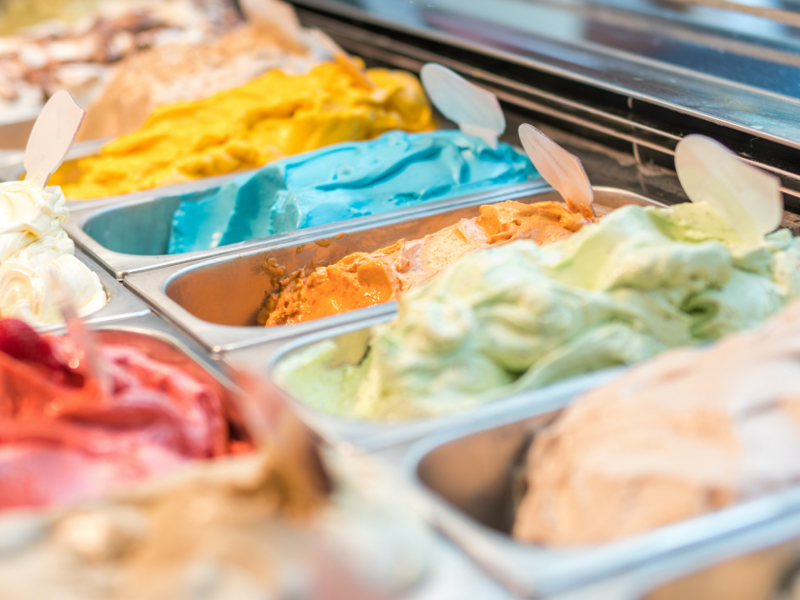
The ice cream mixture is an A (gaseous phase ) + (O/W) emulsion. An emulsifier can reduce the tension between oil and water. At the two interfaces, a multi-molecule adsorption film with mechanical strength is formed, so that the dispersed phase particles form a double-electron structure and prevent the particles with the same charge from colliding or coalescing. Improve the dispersity of fat, make the ice crystals in the product fine grain size, smooth texture.
Emulsifier has many functions in the process of ice cream production and plays different roles in different stages of production. In the phase of ingredients and homogenization, the emulsifier plays a role in promoting the dispersion of fat and stabilizing the emulsion. Promoting fat cohesion in the aging stage; The freezing stage is to promote the interaction between fat and protein, so that the emulsion is unstable or demulsifying, so as to control the aggregation of fat. The attached fat globules are arranged on tiny air bubbles to form a three-dimensional network of knots that form the backbone of the ice cream, stabilizing the bubbles, improving the shape and stability of the ice cream, and giving it a pleasant texture.
The effect of the emulsifying agent in the ice cream mixture can be summarized as follows:
Emulsifying, making the fat glob appear opaque state with fine distribution and stabilizing it.
Disperse, disperse, and stabilize the particles outside the fat sphere.
Foaming. During the freezing process, the foaming force of the mixture can be improved, the expansion rate can be increased, and the bubbles can be refined to stabilize it.
Improved shape retention, increasing the heat resistance of ice cream at room temperature.
The improvement of storage, reducing the change of products in storage.
To prevent or control the formation of large ice crystals and make the ice cream delicate.
HLB value is the preferred index of emulsifier, which largely determines the performance of the emulsifier. In the selection, according to the composition of the ice cream mixture, process requirements, to determine the required emulsifier. At the same time, it should be pointed out that the HLB value does not take into account the molecular structure characteristics, and the nature and efficacy of emulsifiers are also related to the types, molecular structure, and molecular weight of hydrophilic and oil-philic groups. For the convenience of selection, the following is briefly described.
The practice shows that different kinds of oil-philic groups are arranged in the order of oil-philic strength: aliphatic base > with aliphatic hydrocarbon chain, aromatic base >, aromatic base > with weak water-philic base.
In terms of structure, the hydrophilic emulsifier at one end of the oil-philic chain is more hydrophilic than the hydrophilic emulsifier in the middle of the oil-philic chain.
In terms of molecular weight, the emulsification and dispersion capacity of high molecular weight is better than that of low molecular weight. An emulsifier with a straight-chain structure can only be emulsified with more than 8 carbon atoms, and emulsifier with 10-14 carbon atoms has better emulsification and dispersion. So many factors must be considered when choosing the best emulsifier.
Another important index of emulsifiers is Critical Micelle Concentration, which is the minimum Concentration at which emulsifiers form micelles. Some physical properties of the emulsifier solution, in addition to the interfacial tension, resistivity, osmotic pressure, freezing point, vapor pressure, viscosity, density, increase the solubility, optical scattering, and the change of color, there is a significant change in the critical micelle concentration when these significant changes have taken place by measuring the mutation point, can learn the critical micelle concentration. Emulsification, the dosage of the emulsifier is above the critical micelle concentration.
In the experiment, the emulsifying properties and foaming properties of various emulsifier monomers were studied, and the emulsifying properties and foaming properties of different emulsifiers were measured with a certain proportion. After considering the price of market demand, the optimal proportion of emulsifier was selected and applied in the ice cream production. Based on the viscosity of the ice cream mixture, the taste, structure, shape retention, expansion rate, and melting resistance of the ice cream mixture, the optimum proportion of the ice cream emulsifier was determined.
The amount of emulsifier added in ice cream is related to the fat content in the mixture, which generally increases with the increase of fat content. See the below table for the performance and the number of different emulsifiers.
Name | Source | Performance | Reference Dosage(%) |
Monoglyceride(90%) | Grease | Strong emulsification and inhibition of ice crystal growth, HLB 3.8 | 0.2 |
Sucrose ester | Sucrose, fatty acid | Can be used with monoglycerides (1:1) for ice cream, HLB 3-15 | 0.1~0.3 |
Sorbitan monostearate | Sorbitol, fatty acids | Emulsification, combined with monoglyceride, has a synergistic effect, HLB 4.7 | 0.2~0.3 |
Polysorbate 80 | Sorbitol, fatty acids | Combined with monoglyceride, it has a good effect on delaying the melting time, HLB 15.4 | 0.05~0.1 |
Triglyceride | Glycerol, fatty acid | Strong emulsification, HLB 7.2 | 0.1~0.2 |
PG ester | Propylene glycol, grease | It can be combined with monoglyceride to improve the expansion rate and form retention, HLB 3.4 | |
Sodium Caseinate | Casein, sodium hydroxide | High-quality emulsifier and stabilizer | 0.2~0.3 |
lecithin | Egg yolk powder contains 10% | Often used with monoglycerides | 0.1~0.5 |
Soybean phospholipids | Soybean | Often used with monoglycerides, HLB 3.5 | 0.1~0.5 |